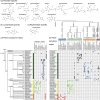Data integration aids understanding of butterfly-host plant networks
- PMID: 28262809
- PMCID: PMC5338290
- DOI: 10.1038/srep43368
Data integration aids understanding of butterfly-host plant networks
Abstract
Although host-plant selection is a central topic in ecology, its general underpinnings are poorly understood. Here, we performed a case study focusing on the publicly available data on Japanese butterflies. A combined statistical analysis of plant-herbivore relationships and taxonomy revealed that some butterfly subfamilies in different families feed on the same plant families, and the occurrence of this phenomenon more than just by chance, thus indicating the independent acquisition of adaptive phenotypes to the same hosts. We consequently integrated plant-herbivore and plant-compound relationship data and conducted a statistical analysis to identify compounds unique to host plants of specific butterfly families. Some of the identified plant compounds are known to attract certain butterfly groups while repelling others. The additional incorporation of insect-compound relationship data revealed potential metabolic processes that are related to host plant selection. Our results demonstrate that data integration enables the computational detection of compounds putatively involved in particular interspecies interactions and that further data enrichment and integration of genomic and transcriptomic data facilitates the unveiling of the molecular mechanisms involved in host plant selection.
Conflict of interest statement
The authors declare no competing financial interests.
Figures







Similar articles
-
Does herbivore diversity depend on plant diversity? The case of California butterflies.Am Nat. 2003 Jan;161(1):40-9. doi: 10.1086/345479. Epub 2002 Dec 11. Am Nat. 2003. PMID: 12650461
-
Alpine butterflies want to fly high: Species and communities shift upwards faster than their host plants.Ecology. 2023 Jan;104(1):e3848. doi: 10.1002/ecy.3848. Epub 2022 Nov 10. Ecology. 2023. PMID: 36366785
-
Herbivore-induced plant volatiles mediate in-flight host discrimination by parasitoids.J Chem Ecol. 2005 Sep;31(9):2033-47. doi: 10.1007/s10886-005-6076-5. Epub 2005 Aug 17. J Chem Ecol. 2005. PMID: 16132211
-
The arms race between heliconiine butterflies and Passiflora plants - new insights on an ancient subject.Biol Rev Camb Philos Soc. 2018 Feb;93(1):555-573. doi: 10.1111/brv.12357. Epub 2017 Sep 13. Biol Rev Camb Philos Soc. 2018. PMID: 28901723 Review.
-
Are exotic host plants a life raft or a trap for butterflies?Curr Opin Insect Sci. 2023 Aug;58:101074. doi: 10.1016/j.cois.2023.101074. Epub 2023 Jun 7. Curr Opin Insect Sci. 2023. PMID: 37290695 Review.
Cited by
-
Plant-moth community relationships at the degraded urban peat-bog in Central Europe.Ecol Evol. 2023 Feb 13;13(2):e9808. doi: 10.1002/ece3.9808. eCollection 2023 Feb. Ecol Evol. 2023. PMID: 36793791 Free PMC article.
-
A phylogenetic study to assess the link between biome specialization and diversification in swallowtail butterflies.Glob Chang Biol. 2022 Oct;28(20):5901-5913. doi: 10.1111/gcb.16344. Epub 2022 Jul 23. Glob Chang Biol. 2022. PMID: 35838418 Free PMC article.
-
Polyhydroxy Acids as Fabaceous Plant Components Induce Oviposition of the Common Grass Yellow Butterfly, Eurema Mandarina.J Chem Ecol. 2023 Feb;49(1-2):67-76. doi: 10.1007/s10886-022-01397-9. Epub 2022 Dec 9. J Chem Ecol. 2023. PMID: 36484901
-
Coexpression of Three Odorant-Binding Protein Genes in the Foreleg Gustatory Sensilla of Swallowtail Butterfly Visualized by Multicolor FISH Analysis.Front Insect Sci. 2021 Jul 30;1:696179. doi: 10.3389/finsc.2021.696179. eCollection 2021. Front Insect Sci. 2021. PMID: 38468877 Free PMC article.
-
Oviposition inhibitor in umbelliferous medicinal plants for the common yellow swallowtail (Papilio machaon).J Nat Med. 2018 Jan;72(1):161-165. doi: 10.1007/s11418-017-1124-3. Epub 2017 Sep 7. J Nat Med. 2018. PMID: 28884433
References
-
- Gatehouse J. A. Plant resistance towards insect herbivores: a dynamic interaction. New Phytol. 156, 145–169 (2002). - PubMed
-
- Konno K. Plant latex and other exudates as plant defense systems: roles of various defense chemicals and proteins contained therein. Phytochemistry. 72 (13), 1510–1530 (2011). - PubMed
-
- Barabási A.-L. Network science. Philos. Trans. R. Soc. A. 371, 20120375 (2013). - PubMed
Publication types
MeSH terms
Substances
LinkOut - more resources
Full Text Sources
Other Literature Sources

